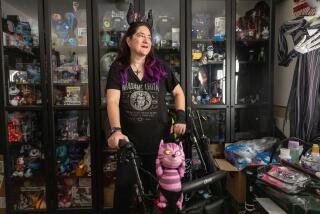Airlines Make Room for Disabled
- Share via
The encouraging news for handicapped travelers, particularly those who can’t get to a lavatory in flight on their own, is that more and more airlines are carrying or will carry some kind of collapsible aisle chairs on their jets.
These chairs, stored on the jets, have generally only been used at airports to help transfer passengers from their own wheelchairs into their seats and vice versa. But passengers have had no onboard chair to use in going to and from the lavatories.
“There are more models of these aisle chairs available and there have been more airline orders of them,” said Ellis Raida, a consultant to airlines on handicapped travel and former executive director of Rehabilitation International, U.S.A., a nonprofit agency.
“I think,” Raida said, “that by the end of 1986, more airlines will have the aisle chairs on wide-body jets used for long flights than those that don’t. Some carriers have delayed making orders, waiting for the best models to emerge.”
World Airways in Forefront
One airline in the forefront of serving handicapped travelers is World Airways, which has aisle chairs on all of its DC-10s and plans to put them also on their 727s. The carrier is also in the process of installing new seats with movable armrests on its DC-10s. Such movable armrests on aisle seats permit easier seating and movement by handicapped travelers.
“We’ll have 12 seats on each DC-10 with movable arm rests by the end of 1986,” said Bob Kirschten, director of administration sales and services for World. Previously, there were were four such seats on most of the DC-10s.
Kirschten said that two lavatories, one forward and one in the rear, have been modified through installation of a grab bar for handicapped travelers to use. “We’re exploring other things as well. There’s still a problem with the threshold of the lavatory, which isn’t as smooth as it could be. So we’re considering putting in an additional grab bar by the wash basin or possibly removing the original grab bar and making one wraparound grab bar.”
Another possibility World is exploring is carrying stretcher patients. “There are now some stretchers that can fit on the top of seat backs,” Kirschten said. “With current technology we can also put in photocell-activated faucets in the lavatories. We have to determine what is really needed by handicapped travelers, and if we can afford the modifications.”
Braille Briefing Booklets
World is one of the carriers that have briefing booklets in Braille, including layouts of the plane. Currently on its DC-10s, comparable Braille booklets are being prepared for the 727s. Subtitles for the hearing-impaired have ben added to its video presentation of emergency procedures, and World has established special service desks at its Oakland and Newark hubs with 800 numbers and trained personnel to assist handicapped travelers.
United is another airline that seems particularly tuned in to the needs of handicapped travelers. All of its Boeing 767s carry aisle chairs, said spokesman Chuck Novak, and 29 DC-8s are being changed to permit use of on-board aisle chairs. Other features of the 767s are four aisle seats with movable arm rests and specially designed lavatories with oversize doors, low entry threshold, built-in assist devices, and increased floor space.
Modifications also include improved call switch access; water faucets which allow one-hand mixing; lever-style handles for toilets and doors, and a lowered door latch. The design also permits creation of a 10-square-foot privacy area adjacent to the lavatory, with this extra space allowing more room for maneuverability and the presence of an attendant or companion.
Not all airlines order new aircraft with the same features.
British Airways is another carrier that provides aisle chairs on board all of its 747 trans-Atlantic flights. Several others carriers, domestic and foreign, offer movable armrests and grab bars in the bathrooms.
Review Asked
Not all the news is good. The Reagan Administration has asked the Supreme Court to review (which the court agreed to do) a lower court ruling it opposes that would make domestic carriers follow a strict set of rules regarding handicapped travelers. These rules, set down by the Civil Aeronautics Board and inherited by the Department of Transportation, were binding on airlines receiving direct subsidies from the government but only served as a general guide for most carriers.
Basically, there are three situations in which an airline may refuse service to a handicapped person: when the handicapped traveler is unwilling or unable to comply with the reasonable requests of airline personnel; when carriage of that person would violate safety requirements set by the Federal Aviation Administration (whose last circular on this subject dates back to 1977), and when that person fails to satisfy advance notice requirements.
Under FAA rules, an airline may require handicapped travelers to fly with attendants when necessary for the safety of other passengers (such as assistance in deplaning during an emergency), or if the person needs extra personal care, or if he or she needs help in complying with the requests of airline personnel.
The rules center on what is considered reasonable under the circumstances, with considerable latitude for judgment on the part of airlines (interpretation of the rules can be different from one airport to another with the same airline). This makes it all the more prudent to determine ahead of time what your particular situation involves.
In this vein, here are some guidelines developed with Mariam Allen-Brownson, who puts out LTD Travel, a newsletter for handicapped travelers (116 Harbor Seal Court, San Mateo, Calif. 94404). While geared especially for passengers who can’t get to the lavatory on their own, these pointers are also pertinent for other handicapped travelers as well.
Obvious Feature
Before you make reservations, find out what kind of features, if any, the airline you might fly on offers handicapped travelers, especially in relation to your condition. Aisle chairs, of course, are an obvious feature for those who can’t get to the lavatory on their own. Try to get information about facilities for handicapped travelers at the airports on your itinerary.
Make your reservation well in advance, and identify yourself as a handicapped traveler. Be prepared to answer some pointed questions about your condition (and if you’re not asked, spell them out yourself). It’s important that the airline know specifically what kind of help you might require, at the departure airport, in flight, at connecting airports, and at the arrival airport.
Find out what the policy is about battery-powered wheelchairs if you plan to travel with one. Not all airlines accept such chairs, and some carriers might refuse to accept wheelchairs without crating insurance. Determine if you are getting a seat especially for handicapped travelers, such as those with movable armrests and near lavatories.
Be sure that all of the relevant information is entered into the airline’s computer.
Get to the airport early for pre-boarding. When overseas, it’s a good idea to check with your airline before you go to the airport to make sure an aisle chair will be available. During your flight, you can ask a stewardess if it’s possible to remind the carrier’s station at your destination that an aisle chair will be needed. Don’t be hesitant in re-emphasizing your deplaning requirements at your destination to flight attendants.
Allow plenty of time when you must use connecting flights, and expect to be deplaned last. Knowledge of terminal location in advance is vital. For example, a domestic flight terminal can be a long way from overseas terminals. Request help, and check in advance the boarding arrangements at each airport.
It’s also a good idea to request your own wheelchair for airport transfers. Airport chairs may be too wide to go through bathroom doors, may have to be pushed by someone else, or may not be available.
More to Read
Sign up for The Wild
We’ll help you find the best places to hike, bike and run, as well as the perfect silent spots for meditation and yoga.
You may occasionally receive promotional content from the Los Angeles Times.






